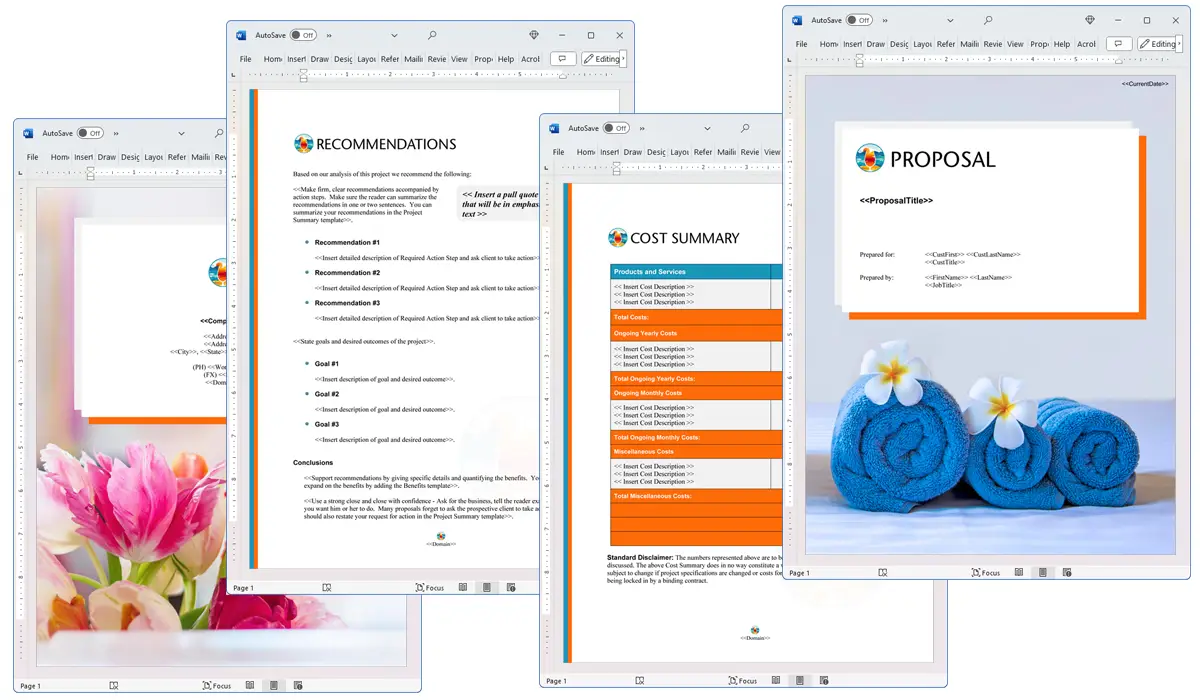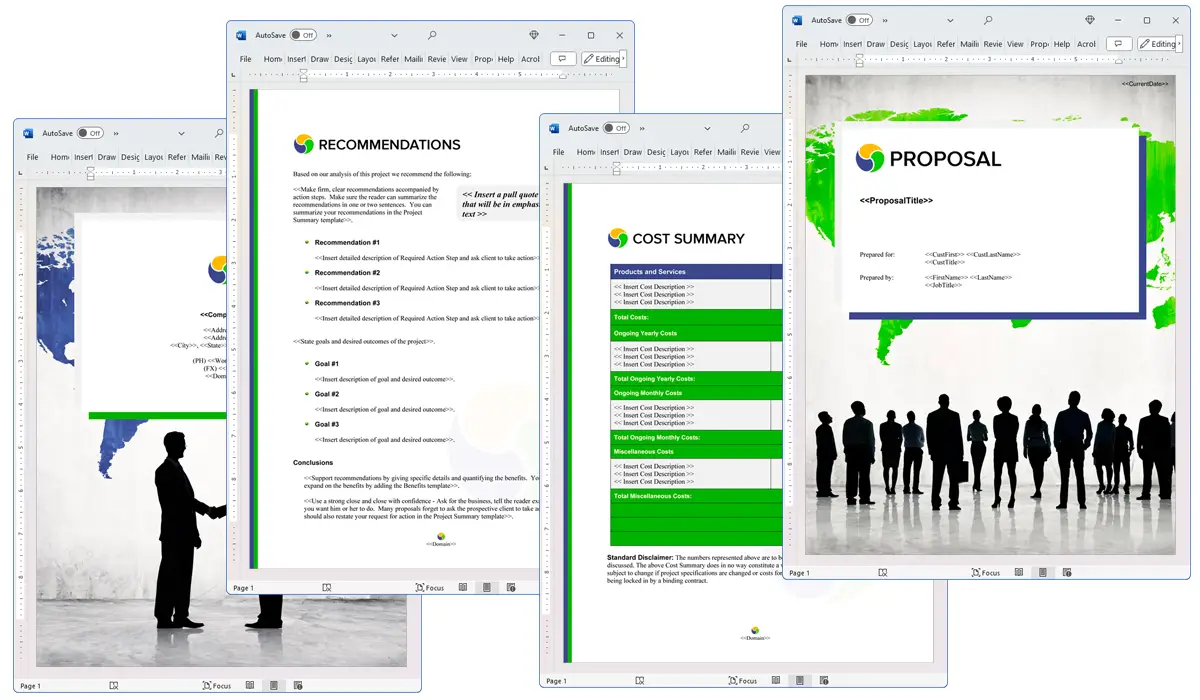What is the Backwards Compatibility chapter used for?
Proposal Kit Professional Bundle adds more design themes, all six Contract Packs,
a project management library, and Expert Edition software.

Illustration of Proposal Pack Hospitality #3
We include this Backwards Compatibility chapter template in every Proposal Pack, along with thousands more. You assemble this chapter with others in various combinations to create custom-tailored business proposals, plans, reports, and other documents. Proposal Packs apply custom visual designs to the templates, giving the final documents a consistent professional finish.
 DOWNLOADABLE, ONE-TIME COST, NO SUBSCRIPTION FEES
DOWNLOADABLE, ONE-TIME COST, NO SUBSCRIPTION FEES
Overview of the Backwards Compatibility Chapter
In the field of business proposals, particularly those involving technical and software projects, the Backwards Compatibility chapter is an important component. This chapter serves as a dedicated section where businesses can discuss how their proposed system or component will maintain compatibility with earlier versions. The significance of including a Backwards Compatibility chapter cannot be overstated, as it reassures potential clients that transitioning to new technology will not disrupt their existing processes or require substantial changes to their current systems.
How is the Backwards Compatibility Chapter Used?
The Backwards Compatibility chapter is used in business proposals to address potential concerns about adopting new technologies. When businesses propose the introduction of new software or system components, stakeholders often worry about the integration with their existing digital environment. This chapter helps to alleviate those concerns by detailing how the new solution will be compatible with older versions, ensuring a smooth and seamless transition. It is a key element that can significantly influence the decision-making process, as it directly speaks to the feasibility and convenience of upgrading to the proposed solution.
What is Included in the Backwards Compatibility Chapter?
This chapter typically includes several important elements:
- Technical Specifications: Detailed descriptions of the technical aspects that ensure compatibility with previous systems.
- Version Support Information: A list of old versions that will be supported by the new system or software.
- Migration Strategies: Outline of methods and tools proposed to facilitate the transition from old versions to the new system.
- Potential Challenges and Solutions: Identification of possible issues that might arise during the integration process and proposed solutions to these problems.
- Benefits of Upgrading: Explanation of the benefits that the new system offers over older versions, while still being compatible.
Use Case Examples for the Backwards Compatibility Chapter
- Software Upgrade Proposals: When proposing an upgrade to a new software version that must work seamlessly with versions currently in use by a client.
- Hardware Component Integration: In situations where new hardware must function with existing older systems within a company.
- IT System Overhaul: During large-scale IT updates, ensuring that new systems are compatible with the legacy systems in place.
- Technical Infrastructure Enhancements: Proposals for enhancements that need to align with existing technical frameworks.
- Web Development Projects: Particularly when new features are added to websites that must not disrupt existing user interfaces or backend processes.
Key Takeaways
- The Backwards Compatibility chapter is vital for proposals that involve introducing new software or systems that interact with older versions.
- It addresses client concerns about potential disruptions during technology upgrades.
- This chapter outlines technical specifications, supported versions, migration strategies, and potential challenges with solutions.
- It is crucial for ensuring stakeholders that new systems will integrate smoothly without necessitating extensive changes.
- Its inclusion in a proposal can significantly enhance the attractiveness of the proposed solution by emphasizing ease of transition and continuity.

Illustration of Proposal Pack Real Estate #8
 What Our Clients Say
What Our Clients SayI purchased the original version of this product back in 2013 when I started my consulting business. the product is great. I love that I don’t have to start any given proposal from scratch- regardless of the type of service I’m providing or the industry. I recommend this product to anyone who has to write any types of proposals for business."
Erestar Inc.
 4.7 stars, based on 845 reviews
4.7 stars, based on 845 reviewsRelated Chapters

The Backwards Compatibility chapter and other chapters are integrated into a Word document as illustrated here in the Proposal Pack Global #5 design theme. There are hundreds of design themes available, and every design theme includes the Backwards Compatibility chapter template.
A proper business proposal will include multiple chapters. This chapter is just one of many you can build into your proposal. We include the complete fill-in-the-blank template in our Proposal Pack template collections. We also include a library of sample proposals illustrating how companies in different industries, both large and small, have written proposals using our Proposal Packs. This template will show you how to write the Backwards Compatibility.
We include a chapter library for you to build from based on your needs. All proposals are different and have different needs and goals. Pick the chapters from our collection and organize them as needed for your proposal.
Using the Proposal Pack template library, you can create any business proposal, report, study, plan, or document.
 Ian Lauder has been helping businesses write their proposals and contracts for two decades. Ian is the owner and founder of Proposal Kit, one of the original sources of business proposal and contract software products started in 1997.
Ian Lauder has been helping businesses write their proposals and contracts for two decades. Ian is the owner and founder of Proposal Kit, one of the original sources of business proposal and contract software products started in 1997.By Ian Lauder
 Published by Proposal Kit, Inc.
Published by Proposal Kit, Inc.


 Cart
Cart
 Facebook
Facebook YouTube
YouTube X
X Search Site
Search Site